S.R.P.I. Puteaux 10x50 Lunette
| Die "Société de Recherches et de Perfectionnements Industriels", kurz S.R.P.I. stellte veschiedene militärische Optiken her. Das vorliegende Fernrohr mit den Werten 10x50 diente entweder als Richt- oder Flakfernrohr. Die Bechriftung auf der Okularseite des runden Porro 2-Gehäuses ist "S.R.P.I. Puteaux - Lunette AB 10x50 (S.R.P.I. 1935) No. 114". Es wurde also 1935 in Puteaux bei Paris gefertigt. Aufgrund des hohen Gewichts von 3165g wurde es mit der Sockelplatte fest oder auf einem Stativ montiert. An der seitlichen Schwalbenschwanzmontage ist ein Schwenkhebel angebracht, der zum Bewegen des Fernrohrs diente (hier fehlt die Abschlusskappe als Gegenlager). Das 10x50 ist aus Messing und grau lackiert (Marine ?). Das Okular hat eine geradlinige Führung und eine zum Betrachter hin gewandte Dioptrienkennzeichnung von +2 bis -4. Die Leder- oder Gummiaugenmuschel fehlt. Ebenfalls ist vor dem Okular ein Fenster mit Gewinde zum Anbringen einer Beleuchtungseinheit, die die Strichplatte mit Kreuzvisier belcuhten konnte. Das Objektiv kann mit einer am Lederriemen gehaltenen Verschlusskappe geschützt werden. In der Mitte der Metallschutzkappe ist ein gelblich-grüner Filter eingbaut. Dieser wird bei Nichtgebrauch des Glases durch eine kleine Lederscheibe am Ende des Befestigungsriemens geschützt. Am unteren Gehäuse befindet sich eine breite Schraube zum Austauschen eines Trockenbehälters. | The "Société de Recherches et de Perfectionnements Industriels", abbreviated to S.R.P.I. made different military optics. The telescope her has 10x50 specifications was euther a targeting sight oder anti-aircarft sight. The inscriptions at the ocular-sided cover if the round porro 2-housing says "S.R.P.I. Puteaux - Lunette AB 10x50 (S.R.P.I. 1935) No. 114". So it was made in 1935 in Puteaux near Paris. The heavy weight of 3165g afforded that it was mounted on a tripod or rack with the ground plate. There is also a dove-tail rail at the side to attach a handle. The handle allowed to adjust the position of the glass (here the counterpart cover is missing). The 10x50 is mae of brass and painted grey (naval ?). The ocular Das Okular has a lienar movement. The dioptre scale is positioned to the viewer and ranges from +2 to -4. The leather or rubber eyecup is missing. Moreoiver, a lighting unit could be screwed onto threaded mount with a tiny window. The glass has a cross-hair reticle. The objective can be protected with a metal cap that is held by a leather strap. The cap has a round yellowish-green filter set into the middle which again can be protected by a round leather piece at the strap end. A screw at the bottom cover of the housing holds a small dessication container. |
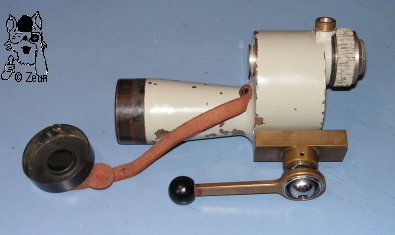

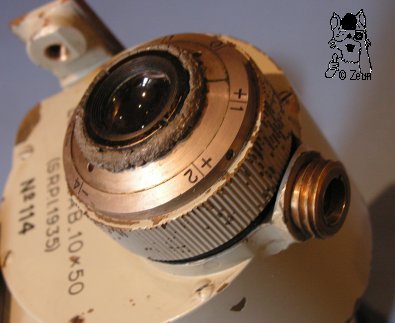
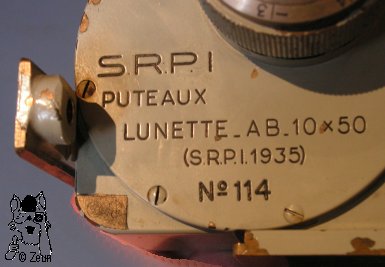
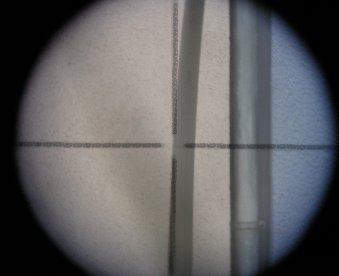
| Das "10x50 Lunette" ist ca. 20cm lang, der konische Objektivtubs 112mm lang, wobei er sich von 44mm auf 59mm im Durchmesser verbreitert. Das Prismengehäuse misst ca. 9x9cm, die Montageplatte ist 60x46mm breit. Der Schwalbenschwanz ist 80x32mm breit und der Schwenkgriff steht ca. 5cm ab und ist 11cm lang. Das Okular ist 35mm hoch und hat einen Durchmesser von 50mm. Die Abdeckkappe misst 62mm im Durchmesser. Ohne Griff und Abdeckkappe verringert sich das Gesamtgewicht um ca. 450g. | The "10x50 Lunette" is c. 20cm long, the conical objective tube measures 112mm. It increases from a 44mm to a 59mm diameter. The prism housing is about 9x9cm, the mounting plate is 60x46mm. The dove-tail is 80x32mm and The lever hanlde protrude c. 5cm and is 11cm in length. The ocular is 35mm tall and has a diameter of 50mm. The protection cap measures 62mm in diameter. Without handle and cap strap the overall wiehgt lessens by 450g. |
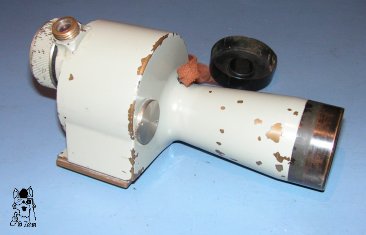
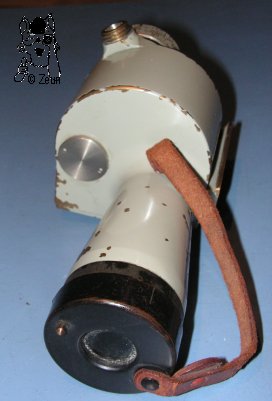
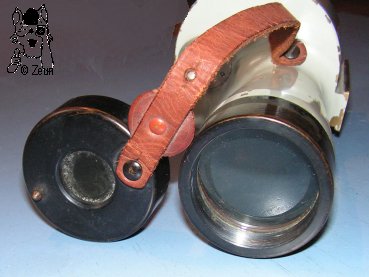
Fotos: Zeun

